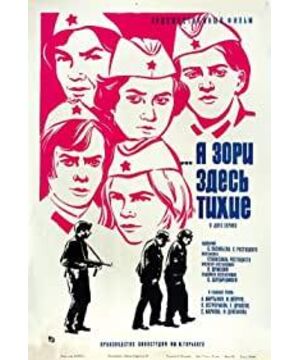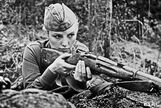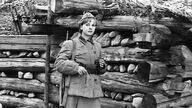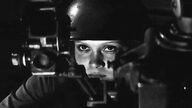Produced by the Soviet Gorky Children's Film Studio
1972 Color 171 minutes
Directed by: S. Rostotsky
Screenwriter: Bau Vasilievs Rostotsky
Photography: Vey Schumsky
1. What to shoot, how to shoot, and why?
The world's major film countries and film masters first mastered the language of the film medium. People often say that letting the picture speak (that is, letting the visual image speak) can be said to measure the language level of an audio-visual work (in the language of words). The standard of what is commonly known in the field as a writer's "literary proficiency"), and it is wrong to measure it in written language (i.e., "dialogue" or "explanation"). Under this premise, we must first learn to "read" the picture and vocal cords. Some people interpret the concept of "reading" as "interpretation", which is a mistake to use the acceptance method of written language to set the acceptance method of audiovisual language. fault. Obviously, the audiovisual image of film and television is intuitive, and the film language uses light waves and sound waves to stimulate the audiovisual senses, rather than identifying a random symbol that needs to be learned and memorized, so it must be read first. post-interpretation, rather than first-interpretation-later-reading.
Please pay attention to such a thing, when many people talk about a work, they are always limited to considering the theme, subject matter, story, and character. It seems that with all this, the success of the work is guaranteed. Such a general phenomenon has been pointed out in Robert Edmund's textbook Picture and Sound. For example, in the more than a thousand years since the birth of Christ, how many painters have painted such a good subject for Christianity as the Virgin and Child? There are probably hundreds of thousands of such works. But how many of them are preserved in art galleries and galleries now? Countless. That is to say, after the subject matter (what to express) is established, the question of how to express it must be considered, which is as important as what to express. A good subject does not necessarily make a good presentation.
When Soviet director Rom asked Eisenstein for advice on his upcoming film, Eisenstein's first words were, "What was your first shot?" This shot is a classic shot, and the second shot should be treated like this, hundreds of shots in the whole film should be like this, every shot in the second film should be like this, every shot in the next film should be like this . In the language of literature, it means "choosing every word". A Hollywood director also once said, "The shot you are shooting should be the most important shot in the whole film. "How to shoot" and "why to shoot like this" should be mentioned on the agenda of our film and TV creation. This aspect is our biggest shortcoming at present. Many directors just can't say "why they shoot like this" for one of his scenes. Even the ready-made scenes shot by others can't be analyzed.
According to the characteristics of "The Dawns Here Are Quiet", this article does not analyze the main paragraphs, but analyzes it from the aspects of audio-visual language, character characterization and structure, and mainly focuses on audio-visual language.
The space of the film
1) The concept of space in Soviet cinema
After watching this film, we may find a problem that the spatial relationship of the places where the events take place in the film is very unclear. Take the station as an example, the position between the warrant officer's residence and the female soldier's dormitory, the anti-aircraft gun position and the bathroom is unclear; the positional relationship around the swamp is also unclear. This way of dealing with space is very different from a Hollywood feature film. Audiences who often watch Hollywood-style feature films may find it very uncomfortable. There are two reasons for this: First, we are familiar with the concept of the stage surface in the processing of movie space. In the stage script, there is a scene description at the beginning. At this time, it is first necessary to explain whether the door is on the left or right of the stage, whether it is open or closed. Where to go, where is the window, what is outside the window, where is the table, where is the vase, etc. This is stipulated in the stage script. In order to occupy the film position, some drama theorists try to separate the stage from the drama, saying that the stage should be abandoned, and the drama cannot be escaped. From our point of view, staging is determined by dramatization. For example, the stage space we are talking about here is determined by the three unity of drama, which is created for stage performance. In the 1930s, Hollywood movies were deeply influenced by drama. Therefore, Hollywood movies must have a stage-style account at the beginning to clearly explain the spatial relationship of the place where the event occurred, although this way of account is larger than that in scale. The stage surface is much larger, starting with a world map or a bird's-eye view of a city, but it is the concept of a stage surface after all. Since the space is set in the first account, the next scene will no longer be inseparable from this space. When the characters are moving and talking, the audience can fully feel the "cocooning" of the characters. It seems that the director and the screenwriter have drawn these characters into prisons, or are possessed by ghosts. No one is allowed to go out until the words are finished. When the words are finished, change the place, and use another account to frame the characters. Continue to speak, and the words are not finished. No one is allowed to go out. Secondly, the concept of the Soviet director and theoretician Pudovkin's composition of film space is to use a camera to take pictures of the required space (using a camera to capture material in reality) , and then form a new film space on the screen, "The material of the film director is not the real processes that take place in real space and time, but the film clips that record these processes. These films are completely subordinate to the person in charge of editing. The director's will." In more professional terms, this space is formed on the editing table, that is, various spaces are intercepted in reality, and then a unique film space relationship is formed on the editing table, and this relationship is in reality. It does not exist in , so this space is not limited by the specific shooting location. The most typical example is the concept of geographic montage. Through the movement of characters, Pudovkin connects Moscow's Red Square and Washington's Capitol Hill into one geographically connected space. He does not observe the relationship of pre-movie space, that is, the spatial relationship of the place where the story takes place before shooting, and Hollywood strictly abides by this pre-movie space relationship. So until now, most Soviet feature films don't use Hollywood's stage-style account shots.
Taking "The Dawn is Quiet" as an example, after the subtitles are over, the first shot seems to be an explanation shot, with the lake in the foreground and a small village in the background. But the second shot immediately jumps into somewhere in the village, a close-up of a soldier who is looking at the swallow's nest on the eaves in a trance. Here's a close-up of a swallow's nest, and the fourth shot is of the Major and Warrant Officer walking out of a house talking and talking. Not only did we not know where the house was located in the village, we didn't even see the whole of the house. That said, the film jumps right into the event in the fourth shot. Since then, the film has no more shots to explain the spatial relationship, and there are very few passages in the whole film that can draw a plan of the spatial relationship of the pre-movie.
Generally speaking, the battle scene needs to pay attention to a little space relationship, otherwise who is shooting against whom? But in this film, even at the first sniper position, we don't know where Lisa's position is and where Sonia's position is. The film simply omits the journey of the warrant officer from Lisa's position to Sonia's position. In the last blocking battle between the warrant officer and Lida and Renya, the position of the three people was also not clearly explained in a single shot. We only know that the warrant officer instructed Lida to pay attention to the situation on the other side of the lake at the same time, so as to prevent the enemy from going there from there. sneak attack. And then an enemy did throw a grenade from there, injuring Lida. That is to say, Lida's position is close to the lake, but the audience still has no way to judge which of the warrant officer and Renia is in the middle and who is on the top. But this is insignificant. Hollywood movies are purely to coax children and tell stories: there was once a mountain, and there was a temple on the mountain... Soviet movies are not about telling stories, but depicting characters, so this kind of account is superficial and inaccurate. Get in the way.
In another scene, the warrant officer took Galia to reconnaissance and met the enemy. Galia ran out of the hidden bushes in fright and was killed by the enemy. The warrant officer immediately returned fire and led the enemy away and followed behind. the other two female fighters. We can find a few examples from this paragraph to study the freedom and flexibility of time and space that other arts do not have.
First of all, the spatial relationship of this passage is not the space of that specific location, but the creator used that location to create a new movie space.
When the warrant officer spotted Deko, we couldn't tell from the screen where the two female fighters were behind. The warrant officer asked Galia to hide in a small bush, and he found another place to hide himself. The spatial relationship between Galia and the warrant officer was not explained. We only see a close-up shot of the two individuals, and a close-up shot of the four German boots passing through the camera from right to left. Then there's a long shot of the two Dekos walking down the slope from left to right (obviously from the warrant officer's view). When the two Dekos had walked two-thirds of the way across the screen, Galia got up from the bushes on the far left and ran to the left. Only then did we figure out the spatial relationship of these three groups of people. And after the warrant officer led the enemy away, it was still unclear where Lida and Renia were standing.
These two examples show once again that such a conception of cinema space is free from the confines of the stage plane of dramatic cinema. However, this concept of film space does not mean that creators can freely use the shots of Suzhou, Hangzhou and Nanjing to compose a space. There are other factors to be considered here. Although these three places belong to Jiangnan, but only in terms of architecture, each has its own style and characteristics. They cannot be integrated.
Another example, the use of the door in this film is also very free. Only the time when the warrant officer broke into the female soldier's dormitory showed the action of the character opening the door. In other cases, not only did he not open the door to enter the room, he did not even enter the room to cover the door, and he did not even explain the door. This is again out of the box of the theater stage.
2) Application of single-lens deep space
The biggest advantage of a single lens is to use the deep space to reveal new information, or to express multi-meaningful relationships. We often see that some film or TV creators who are accustomed to the mode of forward and reverse shooting also need to shoot forward and reverse when using a single lens with a large depth of field, and the effect will not be good. Under normal circumstances, such a large adjustment of the depth perspective will make the audience feel very uncomfortable and uncomfortable. On the one hand, the change in the relationship between the characters is too sudden, and the audience is at a loss; on the other hand, in the large depth of field, the relationship between the foreground and background creates multiple meanings, and the audience needs a certain amount of time to figure it out. When he had a thought, he immediately interrupted his train of thought. For example, the first shot is a close-up of person A, who is meditating in pain, and the second is a close-up of person B who appears in a window behind him, watching A with concern. The third shot is still a close-up of A. The fourth shot is a large depth of field shot from behind B outside the window, with A standing with his back to the camera in the background. The fifth shot is a close-up view of the front of B again, showing sympathy. This kind of processing is really messy. In fact, either use the fourth lens, the B outside the window is in the foreground, and A is in the background, or the first lens is changed to a lens with a large depth of field, the window is included in the background, and B appears in the window. Such a single shot has conveyed all the meaning of the scene, saving many unnecessary front and back shots.
There are some well-handled single shots in The Dawns Here Are Quiet.
For example, in the first episode, the scene where the warrant officer looks at the captured German military map in the room uses a single shot (see the analysis below for details). In addition, in the scene where the warrant officer came to attend the dance of the female fighters, the warrant officer was greeted coldly by the girls and left in anger. The last shot shows Lisa leaning against the door on the right side of the frame, watching the warrant officer walk away in the rain. The shot continues until the warrant officer walks out of the frame on the left, leaving only a profile bust of Lisa staring at him on the right. The director neither switched to Lisa's frontal close-up, nor did he chase after him to give the warrant officer a frontal close-up. This single shot, especially the rain scene, brings Lisa's emotions to the fore. In the scene where Renya kills a Deko for the first time, the director uses the deep space to reveal unexpected information. The warrant officer and the second De Kou were fighting on the ground. In the end, De Kok had the upper hand. The knife he was holding slowly pressed towards the Warrant Officer's throat. It seemed that the Warrant Officer could no longer resist. loose. what happened? The camera immediately cuts to the front half of Deko, who falls to the side with his eyes closed, revealing Renya standing behind him. She stood there, holding her rifle upside down, telling us that she had just given Deko this butt and saved the warrant officer. In a very short single shot, the director uses the method of removing the occlusion (that is, revealing the new space) to reveal new information, which is both concise and powerful, making the scene very compact and powerful. After the climax passed, the director used a slightly longer one-shot, showing Renia, who was suffering from stomach cramps due to excessive tension, vomiting in the right rear position, while the warrant officer leaned down in the left front position to search the jacket pocket of the dead body. In this way, the rhythm slows down.
In the film adaptation, the only obvious content change is the relationship between the warrant officer and the landlady (see appendix). In the film, when Lida found Deko in the woods, she ran back to the village to report, and when she ran to the warrant officer's house, she naturally went up the steps and went to the landlady's room to knock on the door, while shouting loudly : "Warrant Officer! Warrant Officer!" The Warrant Officer unexpectedly got out of the door downstairs. He was wearing a military shirt and apparently just got up from the bed. The action continues to develop around the discovered Deko. But this incidental stroke was cleaned up by the warrant officer. Because both the characters in the film and the audience thought he was living with the landlady before.
These few examples illustrate that film language is far from limited to front and back. Once the audience understands the effects of different treatments of the film space, they can appreciate and understand the film artwork in a deeper way.
3) The use of the so-called "jump axis"
Who stipulated that you can't jump the axis? In the lens language, skip axis is not only allowed, but also has its special utility. It can even be a style. Since there is a method of following the axis of the lens, of course there is also a method of not following the upper axis. This is a dialectical relationship. For example, in "The Dawn is Quiet", the fourth shot after the first episode's subtitles, the warrant officer, major and platoon leader come out of the house on the right side of the screen, they walk towards the camera, then turn right around the corner, walk Go through the window of the house; cut to the next shot, only the major and the warrant officer walk forward from the depths, with the lake next to the village in the background, they come to the foreground, turn right, and meet the soldiers milking the cow. From the shadow cast by the sun on the ground, we can tell that these two shots are big jumping axes. The shadow falls to the right in the previous shot, while it falls to the left in the latter shot.
For another example, before the warrant officer and the five female soldiers were about to pass through Numazu, the warrant officer gave each of them a crutch. Renya deliberately made it difficult for the warrant officer to find out what a crutch was. When the warrant officer replied, "You have a crutch in your hand. That one is called abduction." When Renia said, "Oh, Darry!" He didn't know Darry was referring to Darry's Detailed Dictionary, which was never used by fourth graders, and he appeared in front of the girls again. Ugly now not only stumped the warrant officer, but stung him. The warrant officer had already told the major that he had only studied in the fourth grade, and these female soldiers were all tenth grade graduates. The difference in education level was too great to lead them, and they asked to be transferred to the front line. This is how the director handles the shot. The first two lines of dialogue are that the warrant officer is on the left and Renya is on the right. As soon as the voice of "Dari" falls, the camera skips the axis and shoots from behind the two of them. It becomes the warrant officer is on the right, Renya is on the left, and the warrant officer turns around. With wide eyes, he asked, "What is Darry? Lida said outside the painting, "Stop making trouble, Renia. "This jump axis is extremely unsmooth and has a sense of jumping, but the director used the jump caused by the jump axis to make the audience feel the sting of the warrant officer visually. This is the editing performance, imitating human audiovisual perception Experience.
View more about The Dawns Here Are Quiet reviews






